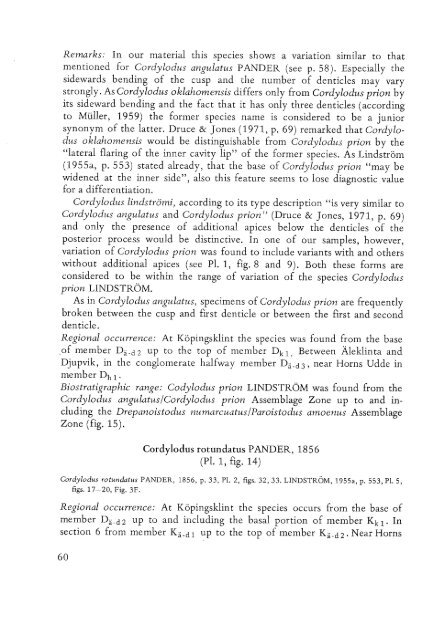UTRECHT MICROPALEONTOLOGICAL BUllETINS
UTRECHT MICROPALEONTOLOGICAL BUllETINS
UTRECHT MICROPALEONTOLOGICAL BUllETINS
You also want an ePaper? Increase the reach of your titles
YUMPU automatically turns print PDFs into web optimized ePapers that Google loves.
Remarks: In our material this species show~ a vanatlOn similar to that<br />
mentioned for Cordylodus angulatus PANDER (see p. 58). Especially the<br />
sidewards bending of the cusp and the number of denticles may vary<br />
strongly. As Cordylodus oklahomensis differs only from Cordylodus prion by<br />
its sideward bending and the fact that it has only three denticles (according<br />
to Muller, 1959) the former species name is considered to be a junior<br />
synonym of the latter. Druce & Jones (1971, p. 69) remarked that Cordylodus<br />
oklahomensis would be distinguishable from Cordylodus prion by the<br />
"lateral flaring of the inner cavity lip" of the former species. As Lindstrom<br />
(1955a, p. 553) stated already, that the base of Cordylodus prion "may be<br />
widened at the inner side", also this feature seems to lose diagnostic value<br />
for a differentiation.<br />
Cordylodus lindstromi, according to its type description "is very similar to<br />
Cordylodus angulatus and Cordylodus prion)} (Druce & Jones, 1971, p. 69)<br />
and only the presence of additional apices below the denticles of the<br />
posterior process would be distinctive. In one of our samples, however,<br />
variation of Cordylodus prion was found to include variants with and others<br />
without additional apices (see PI. 1, fig. 8 and 9). Both these forms are<br />
considered to be within the range of variation of the species Cordylodus<br />
prion LINDSTROM.<br />
As in Cordylodus angulatus, specimens of Cordylodus prion are frequently<br />
broken between the cusp and first denticle or between the first and second<br />
denticle.<br />
Regional occurrence: At Kopingsklint the species was found from the base<br />
.of member Da. d 2 up to the top of member Dk 1. Between Aleklinta and<br />
Djupvik, in the conglomerate halfway member Da. d3 , near Horns Udde in<br />
member D h1 .<br />
Biostratigraphic range: Codylodus prion LINDSTROM was found from the<br />
Cordylodus angulatus/Cordylodus prion Assemblage Zone up to and including<br />
the Drepanoistodus numarcuatus/Paroistodus amoenus Assemblage<br />
Zone (fig. 15).<br />
Cordylodus rotundatus PANDER, 1856<br />
(PI. 1, fig. 14)<br />
Cordylodus rotundatus PANDER, 1856, p. 33, PI. 2, figs. 32,33. LINDSTROM, 1955a, p. 553, PI. 5,<br />
figs. 17-20, Fig. 3F.<br />
Regional occurrence: At Kopingsklint the species occurs from the base of<br />
member Da- d 2 up to and including the basal portion of member Kk l' In<br />
section 6 from member Ka- d 1 up to the top of member Ka- d 2. Near Horns
















